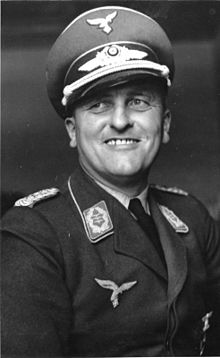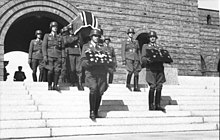Günther Korten
Günther Korten (born July 26, 1898 in Cologne , † July 22, 1944 Karlshof near Rastenburg ) was a German officer , most recently Colonel General and Chief of Staff of the German Air Force in World War II .
Life
Korten was born in Cologne as the son of the government architect Hugo Korten (1855–1931) and his wife Marie, b. Mumm (1866–1942) was born and joined the 2nd Lorraine Field Artillery Regiment No. 34 in September 1914 as a volunteer . In December of the same year, Korten was used as a flag boy in the 8th Engineer Battalion . A little later he was employed as a platoon leader and promoted to lieutenant on October 16, 1915 . After the First World War he was accepted into the Reichswehr , where he mainly served with the pioneer troops. From October 1921 to August 1922 he was assigned to the Central Infantry School in Munich. On April 1, 1925, he was promoted to first lieutenant . Since he had obtained his A pilot's license in August 1926, he was predestined for the secret training of the Reichswehr at the Lipetsk Air Center in the Soviet Union from 1928 onwards. After his return, he moved to the so-called "Bildstelle Berlin", which was supposed to prepare a reconnaissance air force.
With the start of increased rearmament in the Third Reich , Korten switched to the Luftwaffe as a captain in 1934 . Here he was trained as a general staff officer and served for several years in the Reich Ministry of Aviation . At the beginning of the war in 1939 he was Colonel and Chief of Staff of Air Fleet 4 stationed in the former Austria .
At the beginning of 1940, Korten moved to the head of the General Staff of Air Fleet 3 , with which he took part in the campaign in the west and the Battle of Britain . On July 19, he was appointed major general. In January 1941, he switched back to Luftflotte 4 to take part in the Balkan campaign and the attack on the Soviet Union . In August 1942 he was promoted to Lieutenant General and took over command of the 1st Air Corps, which fought on the southern section of the Eastern Front and was temporarily referred to as " Don Air Force Command " during the Battle of Stalingrad .
In the summer of 1943, Korten, who had been promoted to General der Flieger at the beginning of the year , was entrusted with the management of Air Fleet 1 after his predecessor Alfred Keller had been deported to the insignificant post of corps commander of the NSFK . Just a few weeks later, after the suicide of Hans Jeschonnek , Korten was appointed the new Chief of Staff of the Air Force.
During the briefing in Wolfsschanze on July 20, 1944 , during which Colonel Claus Schenk Graf von Stauffenberg detonated the bomb against Adolf Hitler , Korten stood at the right end of the map table in the immediate vicinity of the briefcase with the explosive device and was seriously injured in the explosion. Two days after the assassination attempt , he succumbed to his injuries in the Karlshof hospital at the Führer Headquarters . Like the other military casualties Rudolf Schmundt and Heinz Brandt , he was posthumously promoted one rank, in his case to colonel general . His successor as chief of staff was General Werner Kreipe .
Korten was buried at a major state ceremony on August 3, 1944 in the Tannenberg Reich Memorial . The coffin with the remains was reburied in the Steglitz cemetery in Berlin before the memorial was blown up in January 1945 . The grave is preserved.
Awards
- Iron Cross (1914) 2nd and 1st class
- Wound badge (1918) in black
- Wehrmacht service award IV. To I. class
- Medal in memory of March 13, 1938
- Medal in memory of October 1, 1938
- Clasp for the Iron Cross, 2nd and 1st class
- Pilot and observer badge in gold with diamonds in 1940
- Knight's Cross of the Iron Cross on May 3, 1941
- German cross in gold on December 29, 1942
- Front flight clasp for fighter pilots in gold
- Crimean shield
- Cuff bracelet Crete
- Romanian military order Michael the Brave III. class
- Commander of the Romanian Order Aeronautical Virtue with Swords
- Finnish freedom cross 1st class with star and swords
- Wound badge July 20, 1944
literature
- Karl Friedrich Hildebrand: The Generals of the German Air Force 1935-1945. Volume 2. Habermehl-Nuber. Biblio, Osnabrück 1991, ISBN 3-7648-1701-1 , pp. 217-218.
Web links
Individual evidence
- ↑ Peter Hoffmann: On the assassination attempt in the Führer headquarters "Wolfsschanze" on July 20, 1944 . Ed .: Quarterly Issues for Contemporary History . 1964, p. 273 ( ifz-muenchen.de [PDF]).
- ↑ a b Ranking list of the German Reichsheeres , Mittler & Sohn, Berlin, p. 157.
- ^ Jörg Nimmergut : German medals and decorations until 1945. Volume 4. Württemberg II - German Empire. Central Office for Scientific Order Studies, Munich 2001, ISBN 3-00-001396-2 , p. 2441.
- ↑ a b Veit Scherzer : Knight's Cross bearer 1939–1945. The holders of the Iron Cross of the Army, Air Force, Navy, Waffen-SS, Volkssturm and armed forces allied with Germany according to the documents of the Federal Archives. 2nd Edition. Scherzers Militaer-Verlag, Ranis / Jena 2007, ISBN 978-3-938845-17-2 , p. 467.
- ^ Jörg Nimmergut: German medals and decorations until 1945. Volume 4. Württemberg II - German Empire. Central Office for Scientific Order Studies, Munich 2001, ISBN 3-00-001396-2 , p. 2229.
| personal data | |
|---|---|
| SURNAME | Korten, Günther |
| BRIEF DESCRIPTION | German officer and Chief of Staff of the Air Force in World War II |
| DATE OF BIRTH | July 26, 1898 |
| PLACE OF BIRTH | Cologne |
| DATE OF DEATH | July 22, 1944 |
| Place of death | Görlitz near Rastenburg |


